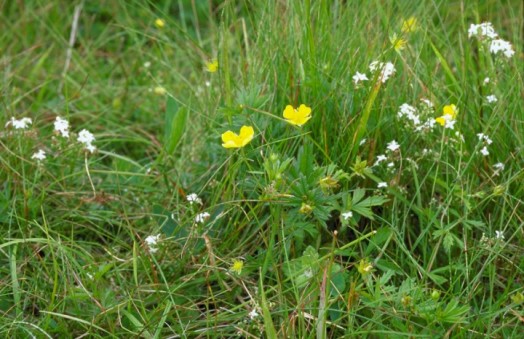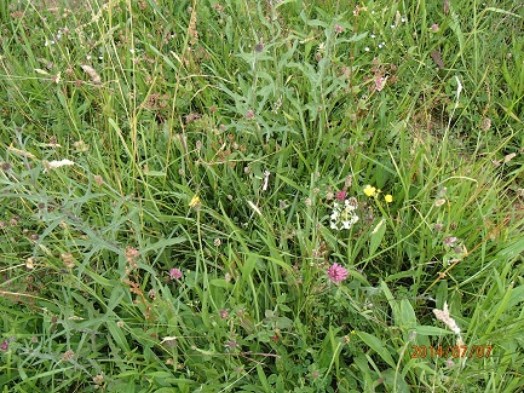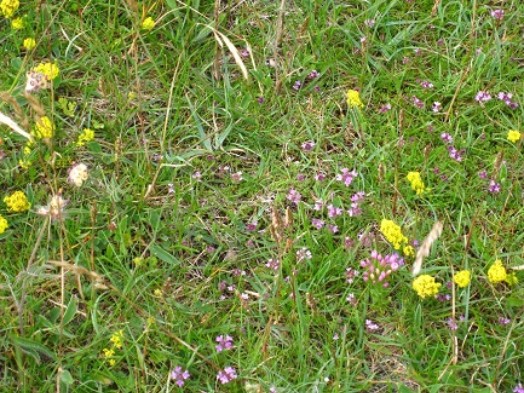Supporting guidance for Species-rich Grassland Management
Date published: 9 November, 2023
For recent changes to this guidance, please see the bottom of the page.
Note: On 28 February 2024 the ‘Guide to Conservation Grazing (SAC)’ at the ‘Further Information’ section was removed and replaced with an updated document titled: ‘Conservation Grazing for Semi-Natural Habitats FAS Technical note TN686’
Introduction
Species-rich grasslands are valuable wildlife habitats and are found throughout Scotland. They have declined dramatically in recent decades and now occupy just two per cent of Scotland’s farmland grassland. They are vulnerable to damage by agricultural improvements, particularly fertilisation, which encourages the growth of a few vigorous grasses at the expense of the great variety of smaller, slower-growing plants.
Flower-rich grasslands support a range of scarce plants, as well as a wide range of other species. Insects are particularly reliant on the food and shelter that these diverse habitats provide. Many species of bumble bee depend upon the pollen and nectar in flowering meadows, and some butterflies, such as the northern brown argus, rely on well-managed calcareous grasslands.
This option will support the maintenance of species-rich grassland lying below the hill dyke. If you wish to include land above the hill dyke in your application you must explain why you consider this land to be species-rich grassland rather than moorland. You should provide either a Phase 1 habitat map of the area, including species lists and target notes and showing the extent of the different habitats, or a map of the National Vegetation Classification communities. Land previously managed as moorland should continue to be managed as moorland.
Types of grassland
Species-rich grasslands vary according to the underlying soil type: acid, neutral or calcareous. This guide to types of species-rich grassland describes the grassland habitats.

1. Acid grassland
Acid grasslands are the typical hill pastures that cover much of upland Scotland but are much less common in the lowlands. Unimproved acid grasslands, undisturbed by ploughing, are particularly important for long-term carbon storage.
Yellow tormentil and white-flowered heath bedstraw, growing together amongst fine-leaved bent and fescue grasses, are good indicators of acid grasslands. There may also be grass-like sedges with grooved leaves and woodrushes with long white hairs on the leaves.
There is never a great variety of wildflowers in acid grasslands, but there may be bluebells (also called harebells), devil’s bit scabious, dog violet, bitter vetch, heath milkwort, spotted orchids and the small red flowers of sheep’s sorrel.
There may also be heather and blaeberry and there is often a layer of moss.
Productivity is generally low.

2. Neutral grassland
Neutral grasslands grow on well-drained or moist neutral brown soils. A wide variety of flowers are typical of these grasslands, including the common knapweed, bird’s-foot trefoil, meadow vetchling, lady’s bedstraw, lady’s mantle, meadow buttercup, yellow rattle, wood crane’s-bill, pignut, yarrow and selfheal, as well as the less colourful ribwort plantain and common sorrel.
Insects such as butterflies and moths, bumble bees and beetles thrive in this flower-rich habitat. Pollinating species in particular benefit from the range and diversity of flower types.
Neutral grasslands were the traditionally managed hay meadows of the past but are easily converted to productive, species-poor grass leys and improved pastures. Few species-rich neutral grasslands have survived the agricultural improvements of the last half-century and the habitat is now reduced to isolated patches scattered through the farmland landscape.

3. Calcareous grassland
Calcareous grassland follows the distribution of calcareous rocks and soils in the landscape. Lime-rich soils are uncommon in Scotland so calcareous grassland is usually found in small patches on shallow soils, on steep slopes, by rock outcrops and on flushed hillsides.
Calcareous grassland is particularly herb-rich. The purple flowers of thyme are the best indicators of the habitat since they are almost always present, growing amongst fine-leaved bent and fescue grasses.
The habitat is usually short, with a variety of small plants such as rockrose, eyebrights, common milkwort, mountain everlasting, mouse-ear hawkweed, alpine meadow-rue, lesser clubmoss and fairy flax, as well as small sedges and the distinctive quaking grass, with flowers that tremble in the wind.
Patches of calcareous grassland are usually found forming mosaics with other grassland types and other habitats. They are typically grazed by sheep.
How to assess if a field is species-rich?
Walk the site and look at the grass sward across the field. In order to qualify the sward must have less than 30% Rye-grass, White clover, Timothy and Cock’s-foot. If the sward has more than 30% it is classed as improved or semi-improved.
Do random stops across the field and look at the flowering species. This guide has images of 26 of the key indicator plant species found in species-rich grassland in Scotland.
What does species-rich grassland look like?

Different species of wildlife need different amounts of light, shade and shelter, as well as different sources of food, so the best grassland for wildlife contains a variety of conditions to suit a variety of plants and animals.
Ideally there will be some short open areas where new seedlings can grow and some dense tussocks to shelter invertebrates and small mammals, with a range of heights between. Plenty of flowers should be visible in summer with bees, moths and butterflies feeding from the flowers on sunny days.
The sward height will be mostly between:
- three and 20 centimetres if it is acid grassland
- five and 20 centimetres if it is neutral grassland
- two and 15 centimetres if it is calcareous grassland
You can measure sward height by placing a hand on the grassland to feel the level that most of the grass leaves reach, ignoring the flowers of grasses and herbs.
The sward should be at its longest in summer, while plants are flowering and setting seed. Most grassland species germinate in the autumn or spring so the sward needs to be shorter at these times, so that there is light and space at ground level for new growth.
What needs to be done?
Species-rich grassland needs to be grazed or cut otherwise the grasses will grow tall and dense and shade out the smaller plants. The traditional management of the grassland – whether it was grazed or cut in the past – is a good guide to the best management for the wildlife living there now.
Grazing is usually the preferred management since grazing animals create variety by eating, dunging and trampling unevenly across the field.
Cattle tend to be better suited to taller grasslands and, since they are less selective grazers than sheep, light summer grazing with cattle can still allow flowering and seed set. Grazing the sward back after plants have flowered and set seed is important to remove rank vegetation, so a short period of higher grazing with cattle from mid August onwards is beneficial.
Sheep may be better suited to grazing shorter grasslands, particularly on fragile sites vulnerable to poaching. Since they selectively eat flowers, a four to eight week exclusion period in the summer may be a good idea when you are grazing with sheep.
Tailor grazing levels to allow plants to flower and set seed. This could include full stock exclusion during flowering season or very low grazing levels. Higher stocking densities in late summer (mid August to mid September) will help to remove rank growth.
Be aware of managing grazing levels to prevent poaching of sites, during wet weather, which can lead to weed problems. Consult the SAC Conservation grazing technical note which has guideline stocking densities for different habitat types.
You must complete a grazing management plan, detailing stock type, stocking levels (recorded as lu/ha) over a full calendar year, split into up to four time periods.
All stock movements must be recorded in your Management Diary. No supplementary feeding is permitted on sites managed for species-rich grassland, unless you have prior written approval from NatureScot or RPID submitted alongside your application.
Approval will only be granted in exceptional circumstances. See link to guidance in Further information section below.
Where there are no livestock you can manage species-rich grassland by cutting late in the summer, no earlier than 15 July. Grass cuttings should be baled and removed or they will smother the sward and add to the fertility of the soil, leading to a decline in species-richness.
Grassland managed by cutting alone can be very uniform so it is a good idea to leave five to ten per cent uncut each year, a different area each time, to vary the sward height and allow seed to set seed. Grazing after cutting (aftermath grazing) will also create variety.
Restoring species-rich grassland
You can restore species-rich grassland from species-poor, semi natural grassland by part-cultivating then over-sowing with wildflower seed.
Once the diversified sward has been established, you will need to manage it as for species-rich grassland.
Management of scrub, weeds and bracken
Small amounts of scrub in species-rich grasslands add to the habitat diversity and benefit insects and birds. Appropriate grazing management should help prevent excessive scrub colonisation but additional manual control may be needed on some sites.
Scrub control is funded as separate capital items:
- Control of Scrub or Woody Vegetation – Primary Treatment – Light Vegetation
- Control of Scrub or Woody Vegetation – Primary Treatment – Intermediate and Heavy Vegetation
- Control of Scrub – Follow-up Treatment
- Control of Scrub or Woody Vegetation – Removal from Site of Cut Vegetation
Injurious weeds
Weed species such as docks, ragwort and creeping thistle will need to be controlled where they impact on the overall area of species-rich grassland.
Weed encroachment can become a problem if poaching or supplementary feeding has occurred.
Weeds can be chemically spot-treated provided you have prior written agreement from your case officer.
If the site you propose to manage suffers from weed encroachment, you will need to state how you plan to control weeds over the course of your contract in your Grazing Management Plan.
The spread of bracken gradually smothers ground vegetation, resulting in the loss of species-rich grassland. Ideally, you should control bracken before the understory of wildflowers and grasses has been lost. If the ground vegetation has been completely replaced with dense bracken litter, we recommend you take advice about how to encourage it to regenerate.
Open bracken can provide good habitat for ground-nesting birds and reptiles such as adders. Bracken on south-facing slopes is an important element of pearl bordered fritillary butterfly habitat and care should be taken when controlling bracken where this species is present.
Bracken control can be undertaken as part of your plan and separate funding is available for this. Areas of dense bracken, which result in land being ineligible for BPS cannot have bracken treatment funded through AECS. This must be undertaken at the owners expense. The herbicide Asulam is no longer available to treat bracken, therefore, manual or mechanised treatment should be employed on species-rich sites:
Further information
- Grassland Management guide (NatureScot)
- Types of species rich grassland (NatureScot)
- Identification of species rich grassland - field sheet
- Species Rich grasslands – what they are and why they matter (NatureScot)
- The effects of supplementary feeding on species rich grassland guidance
- Conservation grazing for semi-natural habitats (FAS technical note TN686)
- Land management for butterflies (SAC)
- Grassland Gems: Managing Lawns and Pastures for Fungi (Plantlife)
- Reptile Management Handbook (Amphibian and Reptile Conservation)
- Amphibian Management Handbook (Amphibian and Reptile Conservation)
Recent changes
| Section | Change |
|---|---|
| How to assess if a field is species-rich | New section and added Guide |
| What needs to be done? |
Added sentence to third paragraph stating: Grazing the sward back after plants have flowered and set seed is important to remove rank vegetation, so a short period of higher grazing with cattle from mid August onwards is beneficial. Addition of ‘stock type ‘ in para. 7 Para. 6 -Change of name from Scottish Natural Heritage to Nature Scot and minor revision |
| Restoring and creating species rich grassland |
Heading changed to ‘Restoring species rich grassland’ Text removed relating to creating species rich grassland |
| Injurious weeds | Added text stating: The herbicide Asulam is no longer available to treat bracken, therefore, manual or mechanised treatment should be employed on species-rich sites. Updated link names to two Bracken pages. |
| Further Information | Updated links to sites shown and deletion of link to Management of grasslands for insects (Bugs life) site |
Previous versions
Download guidance
Click 'Download this page' to create a printable version of this guidance you can save or print out.
